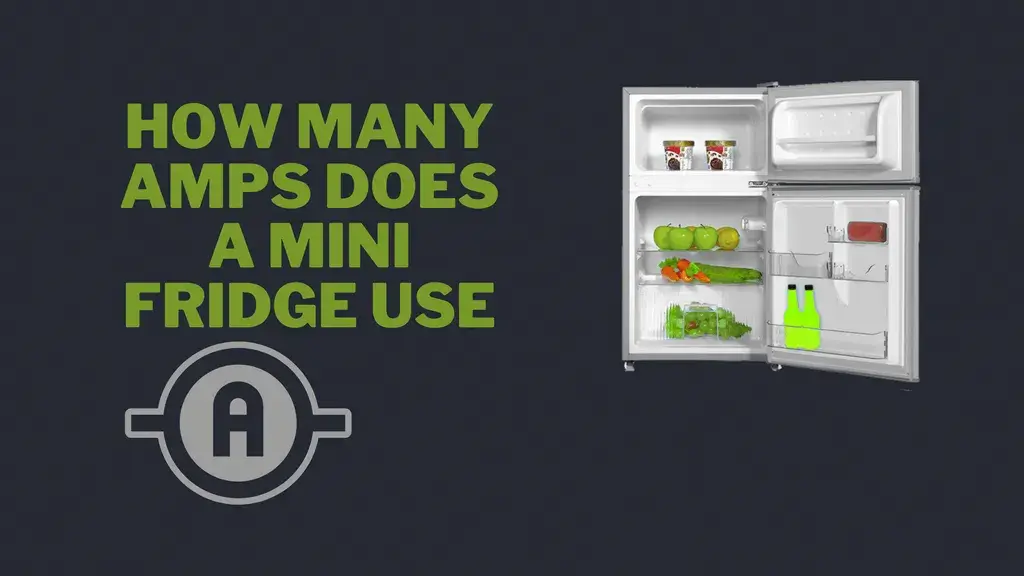How many amps does a mini fridge use? This is a common inquiry that we get asked a lot, and it’s a valid one! Mini fridges can be a great way to keep your food and drinks cold, but you don’t want to end up with an unexpectedly high electric bill.
Refrigerators have an everlasting hunger for power consumption. If you’re a small family trying to reduce your monthly electricity bill, you can go for a mini fridge. But before you buy one, it’s important to be aware of its power usage.
Table Of Contents
- How many amps does a Mini Fridge use?
- How many amps does a Mini Fridge draw on startup?
- How many amps does a 2.7 Mini Fridge use?
- How many amps does a small Wine Fridge use?
- How will you understand if you have a Mini Wine Fridge?
- Does a Mini Fridge consume a lot of electricity?
- What is the cost of operating a Mini Fridge?
- Solar Power System to a Mini Refrigerator
- Facilities of a Mini Fridge
- Disadvantages of a Mini Fridge
- Final Words
- Frequently Asked Questions

How many amps does a Mini Fridge use?
Some of you may not be familiar with the term amps. It’s basically the amount of electricity, your fridge compressor consumes for maintaining the internal cold temperature.
If you want to calculate how many amps a compact refrigerator use, you’ll have to know the wattage first. It’s generally labeled on the metal nameplate or yellow stickers at the back of the fridge, you can also look up the refrigerator model number on the manufacturer’s website to find out the wattage. But in most cases, the latest mini-fridge models are likely to require between 40 to 65 watts on average, while older models may require up to 100 watts. This is because older mini-fridge models are not so energy-efficient and draw more power to cool food and drinks.
In general, mini fridges require somewhere between 2-10 amps of electricity to run them efficiently, depending on the refrigerator model, volume, and size. But here’s the deal – if your mini refrigerator is running on a 12V battery and requires 60 watts of power to operate, the compressor is likely to draw in 5 amps of electricity.
How many amps does a Mini Fridge draw on startup?
Mini refrigerators with low maintenance and lower wattage requirements will draw around 1.0 – 1.2 amps on startup. But on average, mini-fridges with heavy- duty cycles will need at least 1.67 – 2.0 amps for a starting wattage of 200 at 120 volts.
Therefore, it’s a better and safer choice to connect your mini fridge to a dedicated amp circuit that can supply a max of 15 – 20 amps of electricity.
How many amps does a 2.7 Mini Fridge use?
Mini refrigerators are typically of a standard 3.1 cubic ft. size. However, some models can be even smaller in size, measuring 2.7 cups. ft. Such a fridge will require between 700-750 watts of power to start and about 180 watts to run. That comes down to an average of 6.5 amps to start and consumes 1.5-2 amps of electricity per month.
How many amps does a small Wine Fridge use?

We wish there was a straightforward answer to this, but to calculate the number of amps a small wine fridge will require, we need to look at several other factors such as voltage, circuit breaker, etc. On average, good-quality wine fridges typically run on either a 110V, 120V battery or a 240V one. Either way, you don’t need a dedicated circuit to plug in your mini wine fridge, a shared electric circuit will work just fine.
In simplest terms, a mini wine fridge that needs 50-60 watts and can efficiently run on 110 volts will need 0.45 amps. A small 120V wine fridge on the other hand will need about 95-100 watts to run and 0.79 amps of electricity.
How will you understand if you have a Mini Wine Fridge?

If your wine fridge can easily fit 20-22 bottles with ease, you have a small fridge. If your fridge can accommodate fewer wine bottles, less than 20, you have a mini wine fridge then. The amount of electricity needed in amps also depends on the design of your mini wine fridge – does it feature a single zone or dual zone? Wine fridges of a mini size with a dual zone will consume around 0.90-0.95 amps whereas the ones with a single zone are likely to use 0.80-0.85 amps.
Does a Mini Fridge consume a lot of electricity?
A mini fridge typically uses less electricity than a full-size refrigerator. According to the U.S. Department of Energy, the average mini fridge uses around 100 to 150 watts per hour, while a full-size refrigerator uses around 600 to 1,200 watts per hour. However, the actual power consumption of a mini fridge can vary depending on its size, age, and energy efficiency rating.
What is the cost of operating a Mini Fridge?
The cost to run a mini fridge will vary depending on the size of the fridge, the energy efficiency of the unit, and the cost of electricity in your area. On average, a mini fridge will cost around $0.15 to $0.30 per day to run, or between $45 and $90 per year. To find out the specific cost to run your mini fridge, you can use an energy consumption calculator or check the energy rating on the unit.
Solar Power System to a Mini Refrigerator
A mini fridge can run on a small solar panel and battery system. The specific components needed will depend on the power requirements of the fridge, but a typical setup might include a 50-100 watt solar panel, a deep cycle battery, and a charge controller to regulate the power going into the battery. The battery will need to be large enough to power the fridge for several hours without sunlight.
Facilities of a Mini Fridge
- Take up less space than a full-sized refrigerator, making them ideal for small apartments, dorm rooms, or bedrooms.
- Energy efficiency can lead to lower electricity bills and is easily movable.
Disadvantages of a Mini Fridge
- Less storage space than a full-sized refrigerator.
- Tend to be more expensive on a per-unit of storage basis.
- Also, tend to have a shorter lifespan than full-sized refrigerators.
Final Words
If you’re a mini fridge owner curious to find out how many amps your mini fridge use, guess you know it now. Make sure not to put hot stuff in your mini fridge and keep the fridge door open for a long, or else your appliance will draw in much more amps of electricity.